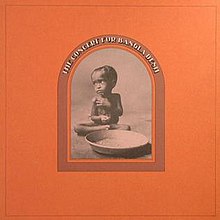| The Concert for Bangladesh | ||||
|---|---|---|---|---|
 | ||||
| Live album by George Harrison & Friends | ||||
| Released | 20 December 1971 | |||
| Recorded | 1 August 1971 | |||
| Venue | Madison Square Garden, New York | |||
| Genre | ||||
| Length | 99:32 | |||
| Label | Apple | |||
| Producer | ||||
| George Harrison chronology | ||||
| ||||
| Alternative cover | ||||
 Cover for the 2005 remastered release | ||||
The Concert for Bangladesh (originally spelt The Concert for Bangla Desh)[2] is a live triple album credited to "George Harrison & Friends"[3][4] and released on Apple Records in December 1971 in the United States and January 1972 in the United Kingdom. The album followed the two concerts of the same name, held on 1 August 1971 at New York's Madison Square Garden, featuring Harrison, Bob Dylan, Ravi Shankar, Ali Akbar Khan, Ringo Starr, Billy Preston, Leon Russell and Eric Clapton. The shows were a pioneering charity event, in aid of the displaced Bengali refugees of the Bangladesh Liberation War, and set the model for future multi-artist rock benefits such as Live Aid (1985) and the Concert for New York City (2001). The event brought Harrison and Starr together on a concert stage for the first time since 1966, when the Beatles retired from live performance, and represented Dylan's first major concert appearance in the U.S. in five years.
Co-produced by Phil Spector, The Concert for Bangladesh features his Wall of Sound approach in a live setting. Besides the main performers, the musicians and singers include Badfinger, Jim Horn, Klaus Voormann, Alla Rakha, Jim Keltner, Jesse Ed Davis and Claudia Lennear. Minimal post-production was carried out on the recordings, ensuring that the album was a faithful document of the event. The box set's packaging included a 64-page book containing photos from the concerts; the album cover, designed by Tom Wilkes, consisted of an image of a malnourished child sitting beside an empty food bowl. The album was delayed for three months due to protracted negotiations between Harrison and two record companies keen to protect their business interests, Capitol and Columbia/CBS.
On release, The Concert for Bangladesh was a major critical and commercial success. It topped albums charts in several countries and went on to win the Grammy Award for Album of the Year in March 1973. Together with the 1972 Apple concert film directed by Saul Swimmer, the album gained Indian classical music its largest Western audience up until that time. It was reissued in 2005, four years after Harrison's death, with revised artwork. As of 2011, sales of the album continue to benefit the George Harrison Fund for UNICEF, which raised $1.2 million for children in the Horn of Africa, in a campaign marking the album's 40th anniversary.
- ^ Moon, p. 808.
- ^ Harry, p. 135.
- ^ Castleman & Podrazik, p. 108; Madinger & Easter, p. 634.
- ^ Don Ovens (charts & reviews dir.), "Billboard Top LP's, for Week Ending Jan. 22, 1972" Archived 24 January 2019 at the Wayback Machine, Billboard, 22 January 1972, p. 70 (retrieved 24 January 2019); "List Grammy Nominees in 47 Categories; Show Mar. 3", Cash Box, 27 January 1973, p. 9.